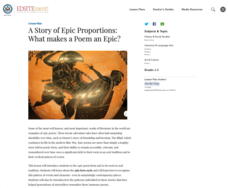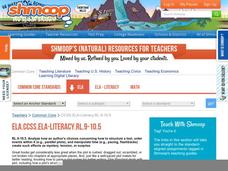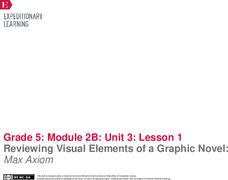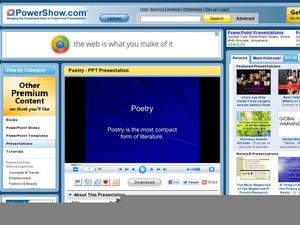K20 LEARN
The New Colossus: Determining Author's Perspective
Introduce young scholars to the concept of the author's perspective with a lesson that uses Emma Lazarus's poem, "The New Colossus," as the anchor text. Groups use a T-chart to identify words that reveal the author's point of view...
Curated OER
The Pied Piper Of Hamelin
Students participate in a lesson that covers the genre of narrative poetry. They examine the elements of a narrative poem while focusing upon the characterization. Students compare and contrast the characters while analyzing their...
Curated OER
Autobiographical Writing
In this unique lesson on autobiographical writing, students compare and contrast three types of writing: narrative, poetry and newspaper. Students prepare to produce a short autobiographical writing based on the framework of one of the...
National Endowment for the Humanities
A Story of Epic Proportions: What Makes a Poem an Epic?
Learners analyze the epic poem form and its roots in oral tradition. In this epic poetry lesson, students research the epic hero cycle and recognize the pattern of events and elements. Learners analyze the patterns embedded in the stories.
Curated OER
Performance and Reflection on Listening and Speaking
Students prepare for and evaluate their performances in poetry slams. In this literature lesson, students write personal narratives about their poetry slam experiences.
Curated OER
Autobiographical Writing
Second graders explore, examine and study the style of autobiographical writing and the relationship with the author. They rad three different types of autobiographical writings: narrative, poetry and newspaper article. Each student...
Curated OER
Poetry Cut-Ups
Students write with controlled and/or subtle organization. They sustain a logical order. Students include a recognizable beginning, middle and end. Students begin by selecting a narrative poem.
Curated OER
Batter Up! Rediscover the Poem "Casey at the Bat"
The baseball themed poem, "Casey at the Bat" is a great summertime focus for reading and writing.
Curated OER
Picture This
Elementary writers practice writing descriptive paragraphs by adding adjectives and sensory words to their writing. They use a picture of a monster for their descriptive paragraph. This 12-page lesson should increase your charges...
Curated OER
Letters From Rifka
Small groups read assigned chapters from the book, Letters to Rifka, then work together to fill out comprehension worksheets associated with their chapters. This fine, 13-page lesson culminates with each group getting together to meet...
Curated OER
Different Types of Poetry
Provide pupils samples of different types of poems including haikus, narrative, nonsense, shape, and rhyming poems. In groups, class members read the poems, establish their general meaning, identify poetic devices, and rate the poems,...
Curated OER
Elements of Poetry
Prepare your learners to identify figurative language in poetry. Tips for reading poetry and what to look for are listed on these slides. Rhetorical devices are defined and plenty of examples are given.
Curated OER
Love That Dog and Hate That Cat Teacher's Guide
This teaching guide for Love That Dog and Hate That Cat includes suggestions for how to integrate Sharon Creech's books into a poetry unit, as well as writing activities, discussion questions, and tips for making poetry...
Curated OER
Analyzing the Use of Irony in a Short Story
Ninth graders examine how literature connects to real-life and see how irony aids in the development of theme. They read Shirley Jackson's The Lottery, and discuss elements of foreshadowing and situational irony. Then learners will write...
Curated OER
Literature: What is it?
Eleven slides answer the question "What is literature?" with simple definitions and categories. Each genre of literature is briefly explained and split into subcategories. These bright, colorful slides work well to introduce literature...
EngageNY
Writing Interview Questions
And now for the star witness! Scholars take a look at a model newspaper article and discuss the importance of eyewitness accounts. In groups of three, they take turns underlining text from eyewitnesses. They then regroup to talk about...
Shmoop
ELA.CCSS.ELA-Literacy.RL.9-10.5
Your students already know when they like a story and when they don't, but they may not know that the plots of these stories are shaping that opinion. Like all resources in this series, the two activities and quizzes provided here deal...
Schools United to Provide Enhanced Resources Network
AP English Project: Journal of Literary Terms and Devices
To prepare for the AP English exams, individuals are asked to create a notebook of literary terms and devices. The terms must be defined, accompanied by representative artwork, and illustrated by an example drawn for a named source. A...
EngageNY
Reviewing Visual Elements of a Graphic Novel: Max Axiom
Pass the tea! Using the resource, scholars participate in a Tea Party protocol to analyze text and images about inventions that helped meet societal demands. After sharing their observations with each other, they discuss visual elements...
Curated OER
Poetry: The Most Compact Form of Literature
Introducing or need to review literary devices and terms for a study of poetry? Though text heavy, the explanations and examples of key poetic devices will provide learners with the vocabulary they need to discuss and craft poems.
Curated OER
Metaphor
High schoolers identify the distinction between literal and figurative language with a focus on metaphors. They complete a metaphor analysis chart, then practice expanding metaphors by composing their own comparisons of elements of the...
Curated OER
Illinois Biodiversity
Students examine the amount of biodiversity in the state of Illinois. They practice using new vocabulary and listening to stories about animals. After given time to reflect, they write their own haiku. They work together to create a...
Curated OER
Using Reader's Theater in the Classroom
Here are some suggestions for using Reader's Theater in the classroom.
Curated OER
A Journey To Japan Through Poetry
Third graders gain an appreciation for writing, analyzing, reading and listening to poetry, viewing poems as a motivation for studying Japanese culture and tradition. They study and create their own haiku and tanka poems with illustrations.
Other popular searches
- Narrative Poetry Examples
- Narrative Poetry Writing
- Narrative Poetry Test
- Poetic Form Narrative
- Lyrical and Narrative Poetry
- Narrative Poetry Ballad
- Define Narrative Poetry
- Non Fiction Narrative Poetry
- Narrative Poetry Lesson Plan
- Elements of Narrative Poetry
- Narrative Writing Poetry

























